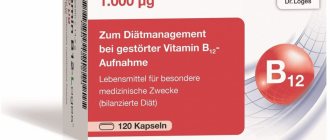Vitamin D successfully participates in thirty biochemical reactions that occur during human metabolism. Its presence is necessary in sufficient quantities throughout the entire calendar year, so a person who wants to stay healthy no longer has to wonder why vitamin D3 is needed.
There are two most useful forms:
- D2 (ergocalciferol), which enters the body with food (fatty fish, animal liver and kidneys, egg yolks, dairy products, butter, hard cheeses);
- D3 (cholecalciferol). It comes from food and is also synthesized in the body independently.
The importance of vitamin D plays an important role starting from birth, or rather, from the moment a person is conceived. The direct participation of the element in the metabolism of calcium and phosphorus, which, like “bricks”, build the child’s bone skeleton, is extremely important during the period of growth and formation. This is a real “protector” that prevents the risk of developing rickets in premature and weak newborn babies.
By taking vitamin D3, a child is almost 100% able to meet the need for the microelement in the body. This is especially important in the absence of breastfeeding (before complementary feeding). With the help of vitamin D, metabolic processes in cartilage, joint and bone tissues are supported throughout the entire period of life, and losses during menopause and with the onset of old age are compensated. The need for vitamin D is vital for both children and adults, pregnant and lactating women. This rule especially applies to regions with reduced solar activity and a small number of clear days.
The mechanism of formation of vitamin D3 is closely related to the absorption and production of ultraviolet radiation by human skin and exposure to air in open clothing.
Important! Exposure of an adult to the sun for about 6 hours in open clothing provides a daily dose of vitamin D of 10 mcg.
Risk factors for the development of vitamin deficiency
Let's look at the main reasons why vitamin deficiency may occur:
- Vegetarianism, dieting.
- Limited exposure to sunlight.
- Dark skin color.
- Limited sleep, night shifts.
- Living in environmentally unsafe areas.
- Chronic gastrointestinal diseases.
If we take into account possible dietary errors and infrequent exposure to the sun, it becomes clear that there is a risk of vitamin D deficiency in a large percentage of people (both children and adults).
How to take vitamin D
Nowadays there is a lot of talk about vitamin D deficiency and the need to check its level. Especially among residents of northern latitudes, which include most of Russia. Some people dispute the need for prophylactic vitamin D supplementation in adults, while others associate almost all ailments with vitamin deficiency.
We have made a simple and understandable Vitamin D Calculator. Enter the results of the 25-OH vitamin D analysis into it and it will calculate the dosage and regimen you need.
Vitamin D Calculator
You made up your mind, you took the vitamin D test, you got the result and...?
The Russian Association of Endocrinologists suggests that 25-OH vitamin D levels above 30 ng/ml are considered sufficient. Anything below is insufficiency and deficiency.
Should we strive to increase this level to the upper limit of the reference intervals (100 ng/ml)?
No. Not worth it. Moreover, if the level of 25-OH vitamin D is above 80 mg/ml, it is worth reconsidering the intake of foods and medications containing vitamin D. Excessive intake of vitamin D can lead to hypervitaminosis (headache, abdominal pain, joint pain, calcium deposition in tissues ). It should be noted that exposure to the sun does not have a negative effect, even if the level of 25-OH vitamin D in the blood is 100 ng/ml.
What to do if your vitamin D test is normal?
Maintain this indicator at the level of 30-60 ng/ml. Walking in the sun? Do you eat fish? If not, doctors recommend taking colecalciferol (vitamin D3) drugs in a prophylactic dosage of 800-1000 IU per day. A higher dosage (1500-2000 IU) is recommended for people over 50 years of age, with fractures, in the complete absence of sun exposure, and with a pre-existing vitamin D deficiency to prevent relapse. If you have obesity or problems with the gastrointestinal tract, it is recommended to increase the daily dose of vitamin D to 3000-6000 IU.
What to do if there is a lack of vitamin D in the blood?
If the result of the 25-OH vitamin D test is 20-29 ng/ml, it is recommended to take colecalciferol (D3) drugs in a total dose of 200 thousand IU over 4 weeks:
- once a month – 200 thousand IU
- once a week – 50 thousand IU
- once a day – 7 thousand IU
- If there is obesity or problems with the gastrointestinal tract, the daily dose of vitamin D is increased to 8000 - 10000 IU.
You can use our recommendations for taking vitamin D. The calculator will calculate the dosage and offer you a dosage regimen.
Vitamin D Calculator
What if the 25-OH vitamin D result is less than 20 ng/ml?
Everything is the same, but for a period of 8 weeks (total dosage of vitamin D 400 thousand IU).
How to convert ME into drops and capsules?
IU in English is denoted IU. The description of each drug states the content of IU (IU) in 1 drop (drop) of liquid form or in 1 capsule. Be careful, because the same dosage in drops or capsules of different drugs may contain different amounts of vitamin D. With your doctor, choose a drug with a dosage that is convenient for taking depending on the prescribed treatment/prevention regimen for vitamin D deficiency.
What to do if you take vitamin D for a long time?
Get tested for vitamin D. It is dangerous to take more than 4 thousand IU of vitamin D daily for longer than 6 months without control (more than 10 thousand IU against the background of obesity).
Which vitamin D supplement should you choose?
When treating vitamin D deficiency/insufficiency, preference is given to the D3 form (colecalciferol). Not all forms and dosages of vitamin D are available in Russia. Do not choose the active metabolites of vitamin D and their analogues - calcitriol and alfacalcidol - on your own. They are used as prescribed by a doctor according to strict indications, under the control of calcium levels in the blood and urine, and the level of parathyroid hormone in the blood.
Can I use a combination of vitamin D and calcium?
When treating vitamin D deficiency/insufficiency due to osteoporosis, endocrinologists recommend simultaneous intake of vitamin D and calcium (500-1000 mg). Find out what calcium supplements are, who they are indicated for and how they are dosed in the article How to take calcium supplements.
Based on: Clinical guidelines “Vitamin D deficiency in adults”, 2021. – Russian Association of Endocrinologists.
The interpretation of test results, the choice of further examination and treatment is carried out by the attending physician.
Indications for use
Let's consider the main conditions in which it is necessary to replenish vitamin D3 for preventive or therapeutic purposes.
In children:
- Disturbances in the growth and development of bones and joints, skeleton.
- Risk of rickets.
- Signs of vitamin deficiency.
Important! Before taking it, it is recommended to take a blood test to confirm the level of the substance. Based on the results of the examination, the doctor will make an individual prescription, taking into account the patient’s age, indications, place of residence, type of activity, concomitant pathologies, etc.
In adults:
- Presence of signs of vitamin D deficiency.
- Pregnancy and breastfeeding (to prevent pathologies of fetal development).
- Complaints of muscle cramps, spasms.
- Osteoporosis, joint damage, bone fractures.
- Calcium and phosphorus deficiency, poor absorption.
- Bone marrow diseases.
- Complex treatment of cardiovascular system, gastrointestinal tract.
- Enterocolitis.
- Comprehensive treatment of systemic lupus erythematosus, skin tuberculosis, type 2 diabetes, psoriasis.
- Prevention of occupational diseases (in metallurgy).
- Hypoparathyroidism.
- Prescription of glucocorticosteroids.
- Decreased immunity, frequent seasonal diseases.
Important! The use of vitamin D without tests and doctor's prescription is possible only for preventive purposes.
Release form
There are several main forms of vitamin D3: tablets and capsules, softgel capsules filled with fish oil or oil (most often soybean), chewable candies or lozenges, and solution.
Tablets and gelatin capsules are the most common format for any vitamins, but they are absorbed more slowly, and if we talk about tablet forms, they can lose some of the active substances while they go through all stages of complex digestive processes.
The advantage of softgel capsules is that fat-soluble vitamin D is placed in an oil environment, making it better absorbed in the body. In addition, softgel capsules are easier to swallow.
Vitamin D3 in liquid form, as well as in the form of lozenges and candies, is best absorbed. The solution can be diluted in water or in a non-hot drink, and chewing candies are suitable for those who have difficulty swallowing regular capsules or tablets, and it should be noted that there is a pleasant bonus in the form of fruit or berry flavors.
Overdose of the drug
Let's consider the possible risks of excessive use of dietary supplements:
- Indigestion, nausea, vomiting, upset stomach.
- Headaches, dizziness.
- Convulsions, breathing problems.
- Loss of appetite.
- Changes in mood, nervousness.
- Rashes on the body.
- Loss of consciousness.
It should be noted that taking the drug is cumulative. The body creates a kind of reserve, which it spends when you stop using dietary supplements or as needed. If the dosage is followed correctly and the period is not exceeded, then, as a rule, no side effects are observed.
Sources of Vitamin D3
Vitamin D3 is produced in one form - in the form of cholecalciferol, the difference between different supplements lies in the sources from which this cholecalciferol is obtained: fish oil, lanolin, mushrooms and lichens.
Information for vegetarians! Most vitamin D3 supplements are of animal origin, so vitamin D2 (ergocalciferol) supplements may be an alternative.
Lanolin is a wax that is isolated from sheep's wool and undergoes special processing to obtain cholecalciferol. It is lanolin that is most often used as a source of D3; it is well absorbed and does not cause allergic reactions.
Fish oil is also a popular raw material for supplements in liquid or softgel capsule form. Here you need to take into account that the liver of fish, which is more often used as a source, can accumulate mercury and toxins, and the product itself can be “heavy” for the stomach.
Cholecalciferol, obtained from lichens and fungi, is highly digestible and suitable for vegans and vegetarians, but this supplement is very expensive. When calculated per serving: one capsule costs from 20 rubles, for non-vegan products - from 5 to 15 rubles.
Contraindications for use
Let's consider the factors under which you should not additionally drink drugs containing ergocalciferol or cholecalciferol:
- individual intolerance, allergic manifestations;
- excess calcium and phosphorus;
- chronic diseases of the cardiovascular system, gastrointestinal tract in acute form;
- pulmonary tuberculosis;
- uncontrolled use;
- violation of metabolic processes;
- decreased immunity.
You cannot combine the use of vitamin D with calcium single preparations containing this substance, as well as with medications containing phosphorus in any form. Proper use in compliance with the dosage gives a lasting result.
Vitamin D - the vitamin we don't get enough of
Not just fish oil
Officially, vitamin D belongs to the group of fat-soluble vitamins.
It enters our body with food (see Table 1). The food set is so specific that it is unfortunately impossible to provide more than 20–30% of the daily requirement with food alone. With milk protein allergies, lactose intolerance, ovo-vegetarianism and strict vegetarianism, the development of deficiency is almost inevitable.
Table 1. Sources of vitamin D in food1
| Natural food sources | Vitamin D IU (D2 or D3) |
| Wild salmon | 600–1000 IU per 100 g |
| Farm raised salmon | 100–250 IU per 100 g |
| Herring | 294-1676 IU per 100 g |
| Som | 500 IU per 100 g |
| Canned sardines | 300–600 IU per 100 g |
| Canned mackerel | 250 IU per 100 g |
| Canned tuna | 236 IU per 100 g |
| Fish fat | 400–1000 IU per 1 tbsp. spoon |
| UV irradiated mushrooms | 446 IU per 100 g |
| Mushrooms not irradiated with UV | 10–100 IU per 100 g |
| Butter | 52 IU per 100 g |
| Milk | 2 IU per 100 g |
| Milk fortified with vitamin D | 80–100 IU per glass |
| Sour cream | 50 IU per 100 g |
| Egg yolk | 20 IU per 1 piece. |
| Cheese | 44 IU per 100 g |
| Beef liver | 45 IU per 100 g |
Main source of vitamin
The human body is designed very wisely, therefore, in addition to all exotic foods, we also have another wonderful source of this vitamin.
Of course it's sunlight! To synthesize vitamin D in physiological quantities, it is necessary to be in the sun with your limbs exposed to sunlight (from 10 a.m. to 3 p.m.) at least twice a week. In tanned skin, vitamin D synthesis is weakened.
By the way, it’s interesting that you won’t be able to achieve an overdose of vitamin D by tanning. If the skin suddenly synthesizes excess amounts of cholecalciferol (vitamin D3), ultraviolet rays will destroy all excess.
Geographical problem
According to Harvard University, in territories located above the 37th parallel (which is the entire territory of our country), the characteristics of solar radiation due to the more acute angle of incidence of solar rays and their dispersion in the atmosphere from November to March are such that the skin practically does not produce vitamin D, regardless of the time a person spends in the sun.
What you didn't know about vitamin D
What do we know about vitamin D? Synthesis requires sunlight, it is found in fish and is necessary for the prevention of rickets. This is where most parents' knowledge ends. This omission needs to be corrected, since we can talk about vitamin D endlessly.
Why is it needed?
Traditionally it is believed that for the prevention of rickets. Undoubtedly! Vitamin D does regulate calcium and phosphate metabolism, but more and more information is emerging about its effect on the immune system.
Low levels of vitamin D reduce infection protection and increase the risk of developing autoimmune diseases.
These same low levels have effects on the cardiovascular system, endocrine system and skin diseases. Separately, it is worth mentioning the antitumor effect of the use of vitamin D, which scientists are now actively studying.
What is considered normal?
If you paid attention, you noticed that we are talking about the effect of low levels of vitamin D. This raises the question: what level can be considered normal?
To assess the level of vitamin D, you need to do a biochemical blood test and look at the concentration of calcidiol (25(OH)D) - the precursor of the active form of vitamin D. The normal level of calcidiol adopted in our country is at least 30 ng/ml (75 nmol/l ).
How does vitamin D enter the body?
Since childhood, we have known that vitamin D is produced under the influence of ultraviolet radiation.
Unfortunately, the sun's rays cannot provide the daily requirement for this group of biologically active substances.
Firstly, the production of the vitamin is only possible when exposed to B-spectrum ultraviolet radiation, which does not penetrate glass, clothing and sunscreen.
Secondly, the slightest obstacles in the form of dust, smog, cloudiness reduce the synthesis of the vitamin.
Thirdly, the darker the skin, the worse vitamin D is produced in the skin. It is believed that after the 37th northern and southern parallels, the “solar path” significantly loses its effectiveness, and the 37th parallel in the north is, for a moment, the border between North and South Korea, and in the south - a third of South America.
Meanwhile, at the equator things are no better, since staying in the sun for a long time without protection in these areas is simply unsafe. That is why the issue of vitamin D deficiency is most acutely raised in India and African countries.
So where to get it?
Several options: you can get it from food, or you can take supplements. In Western countries, they solved the issue by fortifying foods, since eating foods with a naturally high content of vitamin D (mainly fish and some offal) is expensive.
In Russia, food is not enriched, the classic diet does not fill the need, and you can’t count on the sun: there is only one way out of this - take supplements.
Nowadays, there are many vitamin D preparations for every taste.
Most of the drugs (usually dietary supplements) are made from lanolin (sheep wool), a smaller part from animal products (sea fish) and a very small part in the form of a low-active form of vitamin D is synthesized using mushrooms (to the delight of vegetarians).
How much should I take?
Russia has developed its own recommendations for children, adapted for our country.
Important: to avoid confusion, vitamins are usually dosed in international units (IU). Remember that different manufacturers may have different concentrations of vitamin D in drops, tablets, capsules.
For full-term children from 1 month to 1 year, for the purpose of prevention, vitamin D preparations are recommended in a dose of 1000 IU per day, regardless of the type of feeding and the season of the year.
For the same purpose, vitamin D preparations at a dose of 1500 IU per day are recommended for children aged 1 to 3 years.
From 3 to 18 years of age, vitamin D supplements are recommended at a dose of 1000 IU per day.
Is hypervitaminosis possible?
Toxicity occurs at serum calcidiol concentrations greater than 200 ng/mL, but should be considered at levels greater than 100 ng/mL.
How to suspect hypervitaminosis in a child? Hypervitaminosis is manifested by vomiting, dehydration, abdominal pain, and deterioration of consciousness.
What to eat?
Most cholecalciferol is found in fat from the liver and meat of fish: salmon, tuna and mackerel. According to scientists, two to three fish dishes per week can meet the need for this vitamin. You can get vitamin D from butter, dairy products and egg yolks. A less active form of this vitamin, D2, is found in plant products, such as parsley and nettle, as well as in mushrooms.
As it turns out?
Sunbathing wisely
A person needs the sun to synthesize vitamin D and lift his mood. However, excessive exposure to the sun leads to unpleasant consequences. Make sure you know how to tan properly.
Vitamins of group D include several biologically active substances.
One of them is of greatest importance for human health - cholecalciferol
.
The name “vitamin D” usually means this. For the first time, a certain substance in cod oil that protects against rickets was reported back in 1913 by researchers Elmer McCallum and Margaret Davis from the USA. At first, the substance found was considered to be already discovered vitamin A. Later it turned out that this effect was exerted by another compound, which was called vitamin D. The human body can synthesize vitamin D on its own
.
The substance 7-dihydrocholestorol contained in the skin is converted into cholecalciferol under the influence of sunlight. In countries located close to the Arctic Circle, people often receive too little sunlight to fully provide themselves with vitamin D. According to various sources, from 70 to 90 percent of the population in northern latitudes suffer from a deficiency of this substance. However, there are other ways to obtain it
- from animal products.
What if it's not enough?
Vitamin D is fat soluble and can be stored in the liver. But the body does not have enough of these reserves: it is quickly consumed
in the process of calcium metabolism.
Therefore, a lack of vitamin D leads to a gradual decrease in bone density
- osteoporosis.
Especially in women, in whose body calcium metabolism occurs faster during pregnancy and lactation. Lack of calcium in the body negatively affects the function of nerve cells. In severe form, it provokes excessive activity of neurological reflexes - hypocalcemic tetany, which is expressed in cramps of the arms and legs, as well as spasm of the larynx. In addition, the functioning of the cardiovascular and muscular systems depends on the normal balance of calcium in the body. Vitamin D is very important for infants - its deficiency can lead to rickets
.
Its most serious symptoms are softening and deformation of bones, which leads to improper development of the child’s skeleton. Deficiency can also manifest itself as neurological symptoms: excessive excitability, sweating, impaired muscle tone. It is important to know that vitamin D hypervitaminosis is just as dangerous as its deficiency
. An excess leads to pain in muscles and joints, digestive and cardiovascular disorders.
How many do you need?
According to experts, people who live in latitudes with short, low-sun summers should consume up to 25 micrograms of vitamin D per day
.
The mandatory dose for children under 13 years of age is five mcg, and for infants who are breastfed or mixed fed, pediatricians recommend giving up to an additional 10 mcg of vitamin D per day - after mandatory consultation with a doctor
. In order to meet the daily requirement for vitamin D, a piece of sea fish weighing about 100 g, a small portion of beef or chicken liver or one egg yolk is enough.











